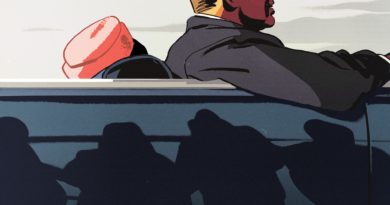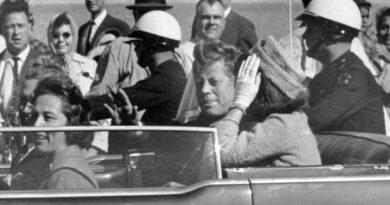Explosive Clams? Document Dumps Shed New Light on Kennedy vs. Castro

The documents, and some of the proposals, reveal the Kennedy administration’s concern with communists across the Florida Strait and a sense of urgency to end the Castro regime, by any means necessary.
“On Feb. 20, 1962, when the world watched as John Glenn was to be the first American to orbit the Earth, the head of the Joint Chiefs of Staff said in a meeting that if the ship blew up and Glenn died, the ‘objective’ could be ‘to provide irrevocable proof that the fault lies with the Communists,’ thereby blaming it on Castro to justify a possible invasion of Cuba,” Branch said.
The documents show the Special Group Augmented, a group President Kennedy formed, looked for ways to create upset among Cuban exiles in the U.S. as well as U.S. citizens, creating a reason to invade Cuba.
“One of those was setting off bombs in Miami and even in Washington, D.C., and blaming it on Castro,” Branch said. “They also considered killing some of the Cuban exiles who were coming over on rafts – men, women and children – and blaming it on Castro, again as a reason to invade.”
A key aspect of the group was being able to deflect blame from the U.S. should one of the possible operations take place. Most of the documents show weak connections to Robert Kennedy and no solid connection to President Kennedy.
“Robert Kennedy’s participation is fairly well documented in these meetings, but it isn’t always clear to what extent he or the president directly authorized the actions that agencies, particularly the CIA, took,” Stroupe said. “They acknowledged, pretty extensively, their use of what they call ‘plausible deniability.’ It’s what you see at the beginning of ‘Mission Impossible,’ where they say if the operation ever becomes public, they disavow any knowledge of the actions.”
Planting Parisites to Disrupt Cuba’s Commerce
One clandestine operation that may have been undertaken was “Operation Square Dance,” Branch said. According to released documents, the idea was biological warfare to destroy the Cuban economy, introducing a parasite into Cuban sugarcane with the goal of crippling the country’s commerce.
“We recently found a document indicating that the head of the Special Group Augmented was informed on Aug. 29, 1962, that a shipment of 80,200 bags of Cuban sugar going to Odessa, then in the Soviet Union, had to dock at a Caribbean port because of a damaged hull. As a result, 14,000 of the 200-pound bags were unloaded,” Branch said.
Although the document is heavily redacted, a U.S. State Department legal adviser said in a separate memo that “The problem of the Cuban sugar now at San Juan [Puerto Rico] has intensified my concern. The fact that the sugar has been treated will almost certainly be discovered through chemical analysis.”
“He said, ‘I have no confidence in the scientific judgment that the substance is harmless.’ He goes on to suggest President Kennedy should be informed and said, ‘I would very much like to be present when this matter is discussed with the president,’” Branch said.
While U.S. leaders’ preoccupation with Cuba and Castro may seem over-the-top and even illegal by today’s standards, their worries occurred at a time when fear of nuclear war between the Soviet Union and the U.S. was at a fevered pitch.
Ballistic Missiles and Nuclear Warheads
In October 1962, reconnaissance photos taken of Cuba proved the Soviet Union was building missile launch facilities, had placed ballistic missiles in the country and stationed bombers which could carry nuclear weapons to the U.S. there. It was discovered later some of those missiles were loaded with nuclear warheads and, if fired, could have resulted in nuclear war, Stroupe said.
The Cuban missile crisis ended after negotiations with the Soviet Union led to removal of the missiles and bombers from Cuba and the removal of NATO missiles placed in Turkey, near the Soviet border.
The Special Group Augmented ceased its function after John F. Kennedy was assassinated in November 1963.
“We don’t fully appreciate it today, but [Cuba and nuclear war were] real concerns at the time. Schoolchildren were doing nuclear bomb exercises in schools, hiding under their desks. The president went on national television and said, essentially, try to make your way as fast as you can to a bomb shelter: Those who aren’t incinerated might be saved,” Stroupe said.
“It wasn’t too far from the McCarthy era and the investigation of communists, and the concern, especially with Castro and Cuba, was that it might be a domino effect, that he would influence other South American countries,” Branch said. “If suddenly all or a big part of South America also became communist, then the U.S. was facing a much deadlier enemy that potentially could invade or cause problems. It would, potentially, undermine the very essence of democracy.
“I think Kennedy, and the nation, fundamentally believed that it was who gets to the button first survives and we have to be prepared at any moment to launch an all-out, worldwide nuclear war,” he said. “They were just on this hair trigger.”
Stroupe said Castro was aware of the Americans considering assassinating him, but his research has yet to turn up any evidence he retaliated.
“We have yet to find any credible evidence that connects Castro directly, or even indirectly, to the Kennedy assassination. But he did threaten,” he said. “While attending a diplomatic reception at the Brazilian embassy in Havana in September 1963, he told Associated Press reporter Daniel Harker, ‘If U.S. leaders are aiding terrorist plans to eliminate Cuban leaders, they themselves will not be safe. Let Kennedy and his brother Robert take care of themselves since they, too, can be a victim of an attempt that can cause their deaths.’ It was reported worldwide.”
That comment still fuels conspiracies about who killed Kennedy, Stroupe said.
“That’s where ‘Castro did it’ conspiracy theories begin,” he said. “But it’s also where most meet a dead end.”

